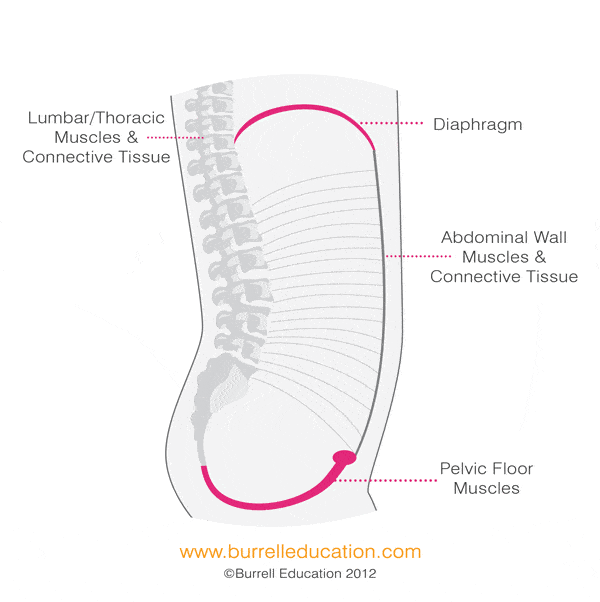The pelvic floor is the set of muscles in the bottom of the pelvis that act like a bowl to hold and direct function of our pelvic organs in every person. The pelvic floor works in concert with the diaphragm we use to breathe in and out.
Functions of the pelvic floor in female bodies
- Supporting pelvic organs (uterus, bladder, bowel)
- Critical for urinating and defecating, maintaining continence
- Keeping pressure stable in the abdomen
- Facilitating giving birth by getting the baby into the right position, and helping to push it out
Understanding the pelvic floor muscles
Strong pelvic floor muscles help your body control your bladder and bowel. If your pelvic floor muscles are weak or dysfunctional, your internal organs are not fully supported.
This weakness can result in leaking of urine (urinary stress incontinence), problems having a bowel motion, and bloating/gas.

Why we may have weak pelvic floor muscles
- Obesity
- Childbirth
- Straining (chronic constipation)
- Age-related loss of collagen and tissue degradation
- High-impact exercise
- Chronic cough
- Lifting heavy things
Why we may have tight pelvic floor muscles
- Over-exercising
- Too many pelvic floor exercises that don’t utilise relaxation enough
- Incorrect pelvic floor exercises
- Sexual trauma, fear of penetration, painful sex (dyspareunia), vaginismus, vulvodynia
Pelvic floor muscles
These muscles form the layer underneath your pelvic organs, covering the bottom of the pelvis. Pelvic organs include the bladder, bowel, and uterus.
The pelvic floor is a set of muscles that are designed to move – relaxing downwards with your breath to accommodate all your internal organs with the fresh air and tightening upwards to expel air.
The pelvic floor has holes in it so that certain tubes can pass through it, including the vaginal canal, the urethra and the anus. These gaps are tight around their tubes, until we need to use them, and then they relax to allow flow/entry.
The pelvic floor muscles are thick and firm, and play a very important role, not just in your pelvis, but throughout your abdomen. We can consciously control these muscles, like an arm or a leg (and unlike, for example, your heart).
We can inadvertently be tightening or relaxing these muscles via the activities, or lack of activities. This might include constant straining to have a bowel motion (makes it loose), shallow breathing (makes it tight), and holding the stomach in to appear slimmer.
Sex and the pelvic floor
The pelvic floor is important for sexual function, with arousal and sexual sensation produced with voluntary contractions. A weak pelvic floor can mean the vagina feels looser, which may only be a sensation in the vagina (not necessarily to a sexual partner).
Pregnancy, giving birth and the pelvic floor These muscles offer support for the growing foetus during pregnancy, and help to push the baby out of the birth canal during birth.
Stabilising the spine
The pelvic floor works together with the abdominal and back muscles to stabilise the spine and offer support. We need this support to walk around, sit, stand, and live our normal lives.
Toning the pelvic floor – strengthening and relaxing
It’s important if you are suffering the consequences of either a tight, weak, or dysfunctional pelvic floor to get professional guidance on what to do.
Each of you is a bit different, and so getting proper guidance on what’s going on, and what to do about it is important for a swift recovery. If you are training the pelvic floor at home, you need to first identify the correct muscles.
How to identify the correct muscles to train
- Lie or sit with your thighs, stomach and buttocks relaxed
- Squeeze the muscle around your anus as if you are trying to stop gas from escaping (wind).
- Now relax. Do this a couple of times, without squeezing your butt muscles or abdominal muscles.
- When you go to the toilet to expel urine, stop and start the stream of urine if you can. This will help you identify the correct muscles. Don’t do this all the time – it’s an identification process for you only.
- Once you have the right muscles identified, squeeze and pull up the muscles around your anus and vagina at the same time. You want them going up.
- Hold tight and count to eight.
- Let them go and fully relax. This will feel like letting go.
- Repeat – squeeze and lift, then relax, both for eight seconds, or as long as you can for the hold.
- Do this set of 12 three times, with a break in between.
- When you breathe throughout the day, make sure you are ‘belly breathing’ or diaphragmatic breathing. This means your belly pushes out on the in breath, and goes in on the out breath.
- A few good rounds are better than more lighter rounds.
- If you don’t feel the muscles contracting and lifting, or you can’t stop your urine stream, you should visit a pelvic health professional for advice.
When to seek medical advice
If you are unable to do these exercises or are unsure what you are trying to do, it is time to see a pelvic physiotherapist, your doctor, or another professional who specialises in the pelvis like a pelvic osteopath.
There is typically no referral necessary for pelvic physio or osteopathy, so you can make a booking anytime you like for a practitioner near you. Don’t wait – the sooner you see someone, the better off you’ll be!




